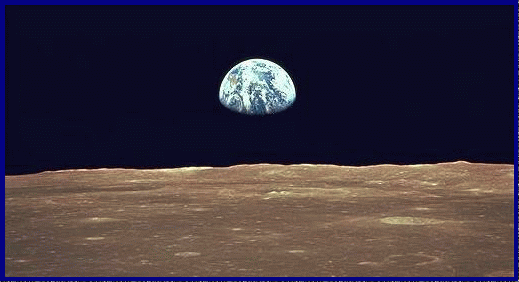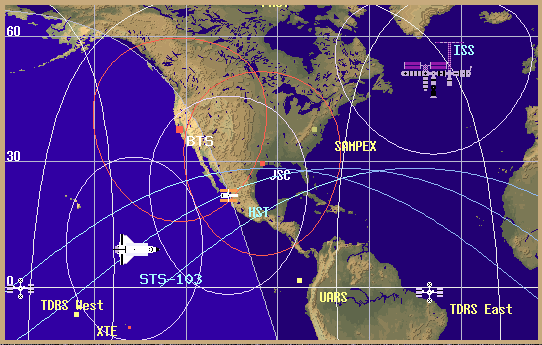 Lesson 2:
Lesson 2:
 Earth
Earth
 Planet of Life
Planet of Life
|
 2.1
2.1
 The Earth From Space
The Earth From Space

|
"Earthrise"
Source: NASA |
Among the millions of striking images generated in the last century (when reporting
the news became virtually identical with the showing of images) surely the most remarkable
is the Earth as seen from the Moon, photographed (in 1969) by the NASA space travelers
Neil Armstrong and Edwin Aldrin. Standing on the lifeless and inhospitable surface of our
familiar and yet alien satellite, without water or air, fully exposed to the harshness
of outer space, the Eagle crew contemplated their lovely home planet, a quarter of a
million miles away.
A symphony in blue and white, with a bit of orange rust, the colors shown by our planet
signal the presence of abundant water as ocean and cloud, and the presence of oxidized
iron. It is our one sample of a planet with life. As long as it is our only sample, we
shall not know whether it is typical for a life-bearing planet or whether it is
some kind of freak phenomenon. Intuitively, one senses that the Moon's environment is
likely to be more common than the Earth's. Requirements are modest: a big disorganized
pile of rocks, driven by gravitational attraction, must coalesce to make one big
spherical heap of rock. The mass is too small to sustain long-term internal heating and
convection, and too small to hold on to an atmosphere. Apparently, Mercury has much the
same origin. In contrast, Earth's history is much more complex, because of internal
gravitational segregation, convection, and the buildup of an ocean and an atmosphere.
Earth's siblings, Venus and Mars, are quite different because the complexity of development
in the terrestrial planets allows for divergent evolution depending on differences in
mass, distance from the Sun and rotation.
 |
Clouds over Africa and the Middle East
Source:NASA |
The face of Earth changes all the time. Swirling cloud systems run along ill-defined latitudinal tracks, more or less symmetrical about the equator. In the bands adjacent
to the equator the motion is to the west, opposite to the sense of the overall rotation. In mid-latitudes, halfway between equator and poles, the motion is to the east, in
the same sense as the rotation of the planet. The reason is simple: eastward motion of the planet's surface is fastest at the equator (40,000 km in 24 hours). When air
parcels arrive from higher latitudes, they tend to lag behind this motion, coming from a region that moves less rapidly toward the east. This lag results in westward
motion relative to the surface. Conversely, air parcels moving away from the equator will tend to get ahead of the local motion. Thus, they move eastward relative to the
surface. The exchange of air masses between low and high latitudes results from winds set up by unequal solar heating.
As the Earth rotates
on its schedule of once every 23 hours and 56 minutes (as seen against the stars), different
landmasses come into view. Their colors,hues of brown and green, change through the seasons,
as does the extent of white areas near the poles. We note that there is an unequal
distribution of land on the planet; there is a lot more of it on the northern hemisphere
than on the southern one. Oddly, there also is a water hemisphere and a land-dominated
hemisphere, with centers in the middle of the largest ocean (say, Christmas Island in the
Pacific) and at the junction of Africa and Eurasia. A large rift separates the western-most
landmasses (the Americas) from the rest, with western and eastern shorelines of the rift
ocean (the Atlantic) running parallel to each other. From space, with sufficiently
precise instruments, we can see that the rift is widening at the rate of roughly an inch
per year (depending on latitude).
Thus the changing face of the Earth. Most recently, geologically speaking, the nature
of the change itself has changed. Within the last two centuries, the human species entered
a new phase of its history. Humans have become a major geologic agent, capturing vast
amounts of water, changing the rates of erosion and the nature of geochemical cycles, and
affecting the heat budget and the climate of the planet. Humans have set foot on a
celestial body other than their home planet. And humans have begun advertising their
presence in the solar system by making the home planet into a strong radio-emitter.
 |
Satellite orbits over North America
Source:
 |
An alien observing station on one of the moons of Jupiter, monitoring the Earth, would
have recorded large changes in the last hundred years, including global warming (since 1900),
nuclear explosions, changes in forest cover, changes in the composition of the atmosphere,
and a rapid increase in the intensity of radio waves. Finally, the Jupiter station would
have recorded a rapid increase in small satellites circling the Earth. The unavoidable
conclusion would be that something unprecedented is happening on Earth, as one of its
life forms is changing the environment in fundamental ways. As the alien observer can tell,
Intelligent Life is making its mark.
Of course, the alien observers would have known all along that Earth harbors Life even
before these latest drastic changes set in. Over the last hundreds of millions of years
Life has changed the Earth's environment, and living things have evolved along with this
change, so that they were "in tune" with the environment. (This makes it look, to the
naive observer, as though Life is changing the environment in a purposeful way, to make
the environment more suitable for Life's continued existence.) The observers would have
noticed that the Earth's atmosphere contains elementary nitrogen and oxygen (each as a
molecule with two atoms) and they would have known that this combination is inherently
unstable. As Hutchinson pointed out in the middle of the last century, bacteria need
to keep renewing the nitrogen gas, and photosynthesizing plants need to keep making
oxygen. Otherwise, after some time, the oxygen would be used up to oxidize carbon,
iron and sulfides, and the nitrogen would end up as ammonia in the air and as
dissolved ammonium, in the ocean.
|





















